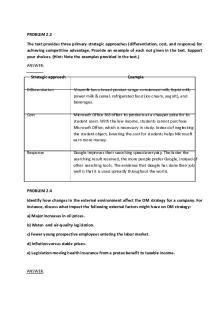Chapter 3 - Scarcity, Trade-Offs, and Production Possibilities PDF

| Title | Chapter 3 - Scarcity, Trade-Offs, and Production Possibilities |
|---|---|
| Author | Dennis Cruz |
| Course | Macroeconomics |
| Institution | Borough of Manhattan Community College |
| Pages | 3 |
| File Size | 43.6 KB |
| File Type | |
| Total Downloads | 107 |
| Total Views | 145 |
Summary
Scarcity, Trade-Offs, and Production Possibilities...
Description
Chapter 3 1. Explain the three fundamental economic questions of What, How and for whom, stating clearly the considerations that determine each question by answering: What goods and services will be produced? This means what is the product or service one is going to offer based on what people want. How will the goods and services be produced? This means the method that is going to be used to produce the product or service. What are the instruments needed to achieve the production? Who will get the goods and services produced? And most importantly who is the product or service directed to. The producer needs to know the market in which the product is going to be offer and the competition there might be. Also, who needs the product, who is it going to be addressed to and who is going to need it or buy it. 2. What is a production possibility curve and explain points of efficiency, inefficiency, and not attainable. The production possibility curve represents the potential total output combinations of any two goods for an economy. It Illustrates and economy's potential by allocating its limited resources for producing various combinations of goods, in a given time period. Efficiency requires society to use its resources to the fullest extent getting the most we can out of our scarce resources: that is, there are no wasted resources. It does not tell us which point along the production possibilities curve is best, but it does tell us that points inside the curve can't be better because there are some wasted resources. If the resources are being used efficiently, at one point
along the production possibilities curve, one or more good or services will be substituted by another. If an economy is operating inside its production possibilities curve, it is not at full capacity, and is operating inefficiently. The economy is not getting the most it can from its scarce resources. Therefore, actual output is less than potential output. 3. Explain the law of increasing opportunity cost in a production possibility curve. What is the reason for increasing opportunity cost? The production possibilities curve is not a straight line, it is concave from below, reflecting increasing opportunity costs of producing additional amounts of a good. The law of increasing costs is a principle that states that once all factors of production (land, labor, capital) are at maximum output and efficiency, producing more will cost more than average. As production increases, the opportunity cost does as well. The basic reason for increasing opportunity cost is that some resources and skills cannot be easily adapted from their current uses to alternative uses. 4. How can a country experience economic growth? An economy can only grow with qualitative or quantitative changes in the factors of production (land, labor, capital, entrepreneurship). Advancements in technology, improvement in labor productivity or new natural resource finds, could all lead to outward shifts of the production possibilities curve. To generate economic growth, a society must produce fewer consumable goods and more capital goods in the present, sacrifice one or more consumer goods in order to experience growth in the future. Investing is another way of growth which increases
the future production capacity of the economy. So an economy that invests more and consumes less now will be able to produce and consume more in the future....
Similar Free PDFs

Week 3 scarcity, work and choice
- 2 Pages

Chapter 7 Production and Growth
- 38 Pages

(2) Scarcity, Work and Choice
- 4 Pages

Post-Scarcity Anarchism
- 11 Pages

Chapitre 3 production
- 16 Pages
Popular Institutions
- Tinajero National High School - Annex
- Politeknik Caltex Riau
- Yokohama City University
- SGT University
- University of Al-Qadisiyah
- Divine Word College of Vigan
- Techniek College Rotterdam
- Universidade de Santiago
- Universiti Teknologi MARA Cawangan Johor Kampus Pasir Gudang
- Poltekkes Kemenkes Yogyakarta
- Baguio City National High School
- Colegio san marcos
- preparatoria uno
- Centro de Bachillerato Tecnológico Industrial y de Servicios No. 107
- Dalian Maritime University
- Quang Trung Secondary School
- Colegio Tecnológico en Informática
- Corporación Regional de Educación Superior
- Grupo CEDVA
- Dar Al Uloom University
- Centro de Estudios Preuniversitarios de la Universidad Nacional de Ingeniería
- 上智大学
- Aakash International School, Nuna Majara
- San Felipe Neri Catholic School
- Kang Chiao International School - New Taipei City
- Misamis Occidental National High School
- Institución Educativa Escuela Normal Juan Ladrilleros
- Kolehiyo ng Pantukan
- Batanes State College
- Instituto Continental
- Sekolah Menengah Kejuruan Kesehatan Kaltara (Tarakan)
- Colegio de La Inmaculada Concepcion - Cebu










